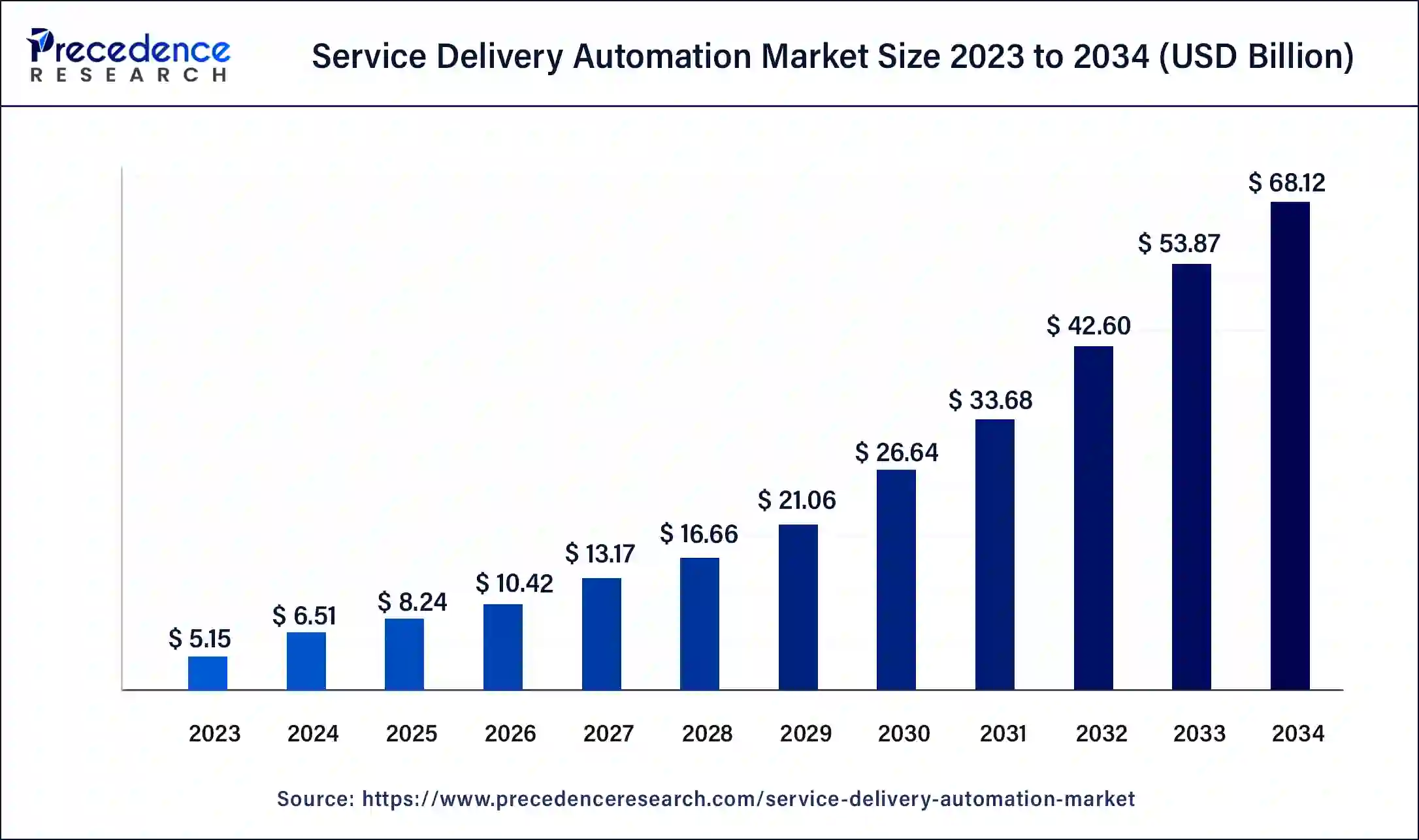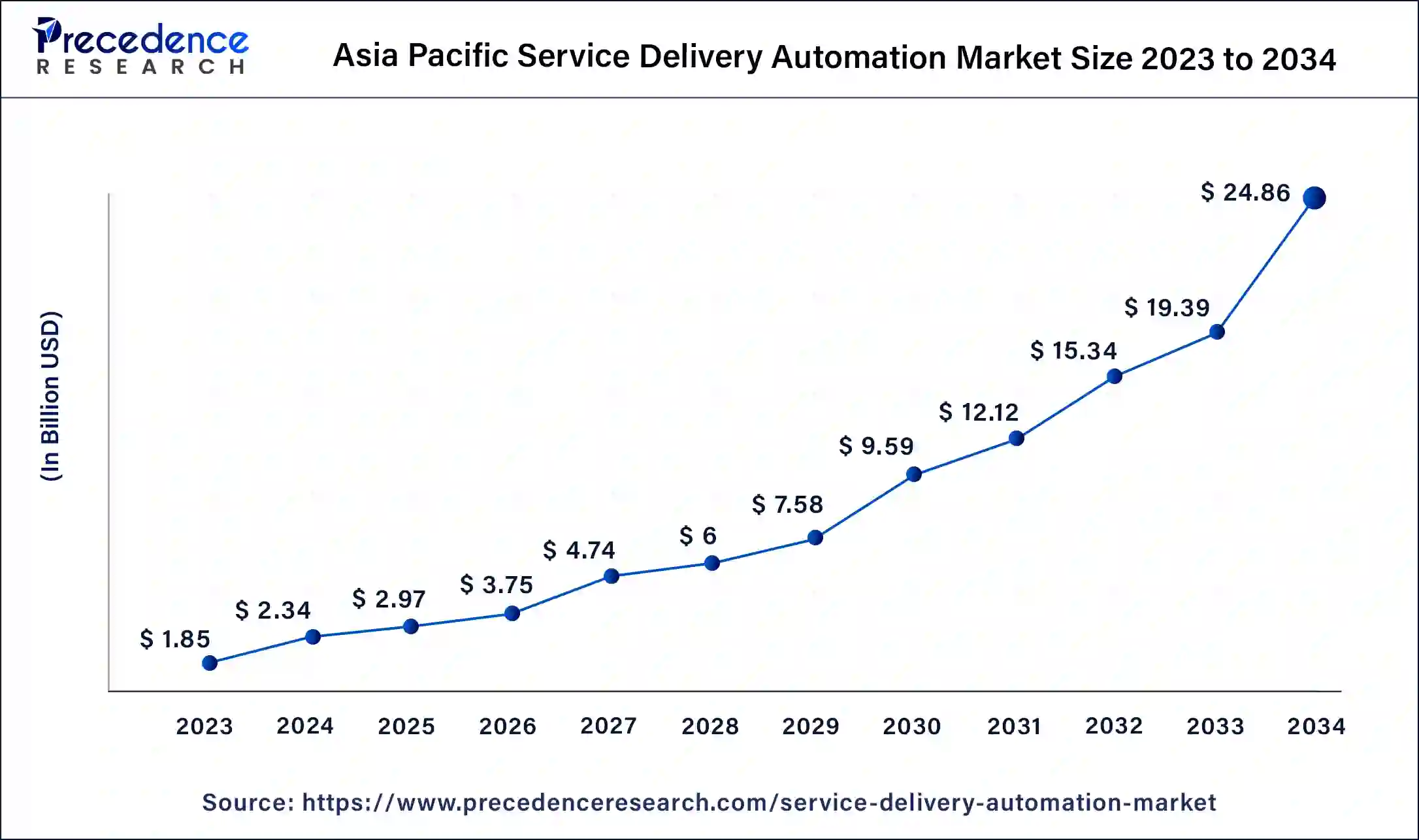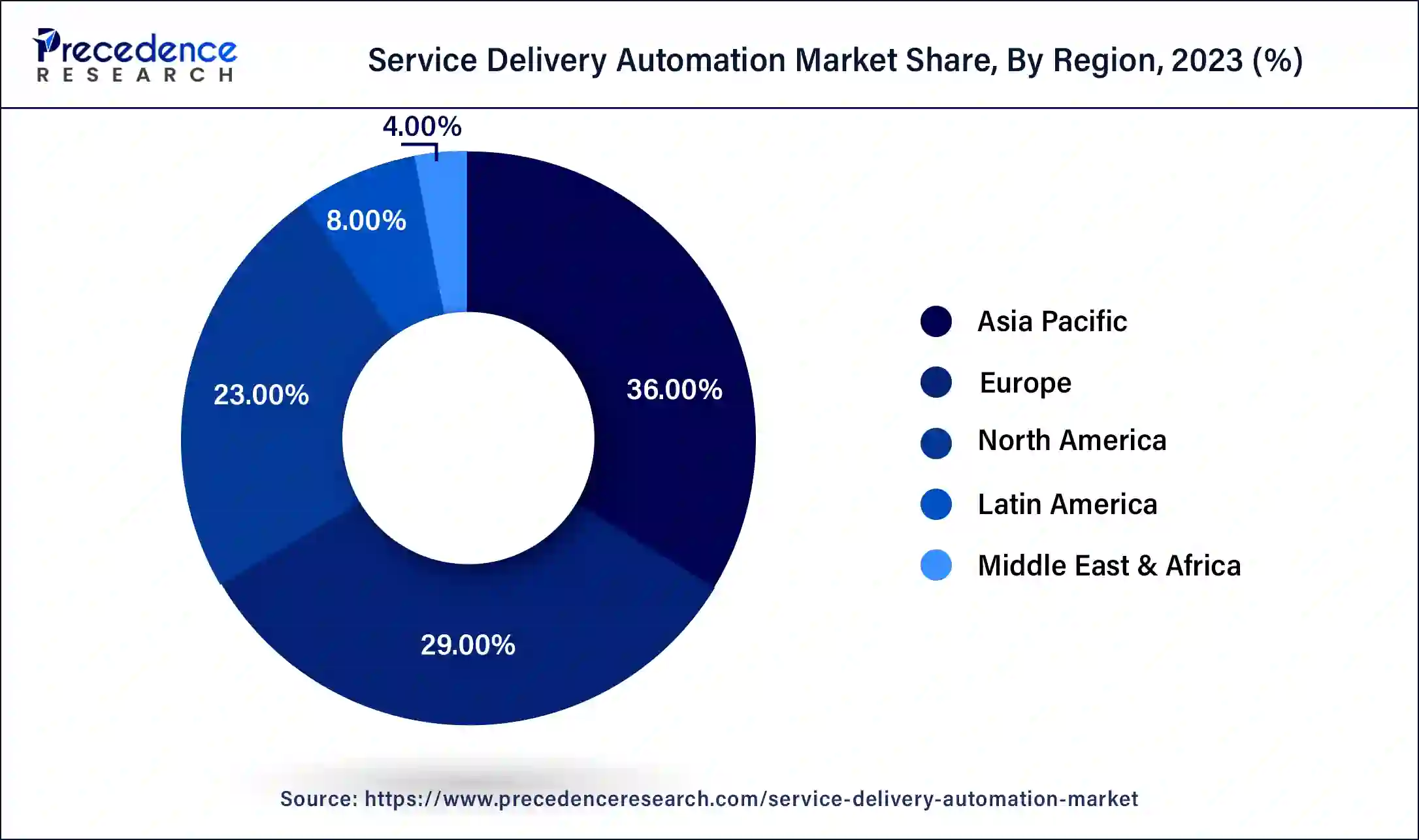December 2024
The global service delivery automation market size surpassed USD 5.15 billion in 2023 and is estimated to increase from USD 6.51 billion in 2024 to approximately USD 68.12 billion by 2034. It is projected to grow at a CAGR of 26.46% from 2024 to 2034.
The global service delivery automation market size is projected to be worth around USD 68.12 billion by 2034 from USD 6.51 billion in 2024, at a CAGR of 26.46% from 2024 to 2034. Businesses are looking for more and more methods to save expenses while improving operational efficiency. This drives the service delivery automation market.

The Asia Pacific service delivery automation market size was exhibited at USD 1.85 billion in 2023 and is projected to be worth around USD 24.86 billion by 2034, poised to grow at a CAGR of 26.64% from 2024 to 2034.

Asia Pacific held the largest share of the service delivery automation market in 2023. Automation technologies are becoming more and more popular among businesses in Asia Pacific as a means of improving productivity and cutting expenses. The service delivery automation market is growing as a result of the requirement for sophisticated analytics to enhance decision-making procedures. The need for SDA solutions is being driven by the growth of the IT and telecom industries.
Businesses are concentrating on digital transformation, which includes leveraging SDA to automate processes. The service delivery automation market is being driven further by a number of government initiatives that encourage the adoption of digital technology and automation. Automation solutions powered by AI are becoming more and more popular because of their capacity to manage intricate operations and offer insightful data. Because it can improve decision-making and mimic human thought processes, this market is expanding.

North America is expected to host the fastest-growing service delivery automation market over the forecast period. The capabilities of SDA solutions are improved by the incorporation of AI and ML, enabling more advanced automation of difficult operations. The automation of routine, rule-based processes is becoming more common in sectors such as retail, healthcare, and finance, thanks to RPA. Businesses use SDA more frequently to cut expenses associated with operations, boost productivity, and simplify workflows. The implementation of SDA is being driven by companies' commitment to enhancing customer experience through faster and more accurate service delivery.
The service delivery automation market lowers the possibility of human mistakes in compliance-related operations by automating them and assisting firms in meeting regulatory standards. The scalability provided by SDA solutions enables companies to manage growing workloads without investing more money in resources. Healthcare automation includes telemedicine services, patient data management, and administrative chores.
The term 'service delivery automation' (SDA) describes how many business and IT activities, including both front- and back-office tasks, can be automated through the use of technology. Tools like artificial intelligence (AI), machine learning (ML), and robotic process automation (RPA) are used to accomplish this automation. The need for more efficiency, lower costs, and better service quality across a range of businesses has led to a notable expansion of the service delivery automation market in recent years. Advances in AI and ML, the requirement for digital transformation, and the growing complexity of business operations are some of the factors driving this increase. Organizations are adopting digital technologies more and more to improve their operations and service delivery.
More complicated processes can be automated thanks to the efficiency and effectiveness of automation solutions being driven by the integration of AI and ML technologies. Businesses are looking for more automated solutions to lower operating expenses and boost output. Enterprises from several sectors are pursuing digital transformation campaigns, frequently involving the integration of SDA solutions. SDA solutions offer enterprises scaleable and adaptable choices for handling complicated procedures and varying workloads. It is anticipated that the service delivery automation market will maintain its strong expansion due to continued technology developments, growing industry acceptance, and the ongoing push toward digital transformation. More advancements in AI and cognitive automation are probably in store for the market, which will expand the uses and functionalities of SDA solutions.
Service Delivery Automation Market Growth Factors
Role of AI in Automation of Delivery Services
Service robots designed for hospitality purpose is equipped with light, tactile, and depth sensors which enable them for navigation complex spaces, object recognition and detection, and customer-friendly interaction. The AI algorithms rely on information collected through sensors and enable the service robots to interpret that sensory data to take autonomous decisions. The use of fully-autonomous robots enables the delivery of services to remote customers by meeting their expectations with enhanced safety and precautions. Intelligent virtual assistants with the help of natural language processing and machine learning algorithms can perform customer query solving, based on previous data of interaction through optimizing service patterns. AI-enabled self-service solutions allow the customers to find answers to their relevant questions from a constantly updating list of frequently-asked questions. The integration of artificial intelligence is crucial for the business communications worldwide and to enhance professionalism in service-oriented management divisions.
| Report Coverage | Details |
| Market Size by 2034 | USD 68.12 Billion |
| Market Size in 2023 | USD 5.15 Billion |
| Market Size in 2024 | USD 6.51 Billion |
| Market Growth Rate from 2024 to 2034 | CAGR of 26.46% |
| Largest Market | Asia Pacific |
| Base Year | 2023 |
| Forecast Period | 2024 to 2034 |
| Segments Covered | Type, Application, and Regions |
| Regions Covered | North America, Europe, Asia-Pacific, Latin America and Middle East & Africa |
Digital transformation initiatives
RPA reduces human error and increases productivity by automating repetitive operations. Organizations can lower labor expenses and redirect resources toward more strategic endeavors by automating routine processes. By enabling chatbots and virtual assistants to comprehend and efficiently reply to consumer inquiries, natural language processing (NLP) improves customer interactions. Remote work and international cooperation are made possible by cloud-based SDA solutions, which are accessible from any location. Real-time data collected by IoT devices can be utilized to expedite service delivery and automate answers. IoT makes it possible to manage and continuously monitor automated systems, guaranteeing peak performance. Among the digital transformation goals is bolstering cybersecurity defenses against intrusions on automated systems. The performance of automated processes can be understood using advanced analytics, which supports strategic decision-making.
Workforce resistance
Organizations adopting automation technology confront a substantial obstacle in the form of workforce opposition in the service delivery automation market. This opposition may result from a number of things, such as worries about shifting job tasks and responsibilities, ignorance about automation technology, and fear of losing one's job. Fear of being replaced by automation technologies, such as artificial intelligence (AI) and robotic process automation (RPA), is one of the main worries of workers. Workers might not be fully aware of the advantages and potential of SDA technology, which could cause misunderstandings and anxiety. Employees who are used to particular duties and workflows may find automation to be uncomfortable as it frequently results in changes to job roles and responsibilities.
Cloud-based automation solutions
With cloud-based solutions, companies can quickly scale up or down their automation capabilities in response to demand without having to make large upfront expenditures in infrastructure or hardware. Businesses can cut costs related to maintaining on-premises software and systems by utilizing cloud infrastructure. In the service delivery automation market service delivery automation market, pay-as-you-go options also facilitate efficient cost management. Teams may operate more easily from different places and integrate with other cloud-based products and services because of cloud solutions' ability to facilitate remote access and collaboration. Prominent cloud companies make significant investments in security measures, such as encryption and adherence to legal requirements, to offer strong protection for confidential information. Compared to traditional on-premises systems, cloud-based automation solutions may be swiftly installed, enabling businesses to incorporate automation and begin reaping its benefits sooner.
The IT process automation segment held the largest share of the service delivery automation market in 2023. The important field of IT process automation (ITPA) focuses on automating standard IT jobs and procedures in order to increase productivity, accuracy, and speed. This is the process of automating rule-based and repetitive processes with software robots, or 'bots.' RPA is capable of handling data entry, system integration, and report creation. Simplifies complicated operations by creating task sequences that must be completed in a particular order. Processes for approval, incident, and change management are a few examples of this.
Improves IT service management through the automation of processes, including change management, issue response, and ticketing. This frequently incorporates with ITSM systems to expedite the provision of services. Focuses on automating cloud-based operations such as resource management, scalability, and provisioning. This section contributes to the reduction of manual intervention and optimization of cloud operations.
The business process segment is expected to grow at the fastest rate in the service delivery automation market over the forecast period. This is the automation of repetitive operations and processes through the use of software robots, or 'bots.' RPA is frequently used for procedures related to customer support, invoice processing, and data entry. The automation of intricate workflows with several departments and steps is the main topic of this section. It seeks to increase productivity, decrease errors in task performance, and streamline procedures. In this section, decision-making procedures that are predicated on established business rules are automated. It aids in guaranteeing uniformity and adherence to different procedures. This covers the automation of tasks related to document management, including the creation, processing, and archiving of documents. It enhances document handling accuracy and minimizes manual labor.
The BFSI segment held the largest share of the service delivery automation market in 2023. Automates routine operations, including transaction processing, data entry, and customer query management. This lowers human mistakes and increases efficiency. Combines machine learning (ML), artificial intelligence (AI), and robotic process automation (RPA) to manage increasingly sophisticated activities, including fraud detection, predictive analytics, and personalized customer care. Consists of chatbots, virtual assistants, and automated response systems that manage complaints, support requests, and consumer queries, increasing customer satisfaction and response times.
Automation solutions that lower the risk of fines and enhance overall compliance by managing regulatory compliance, keeping an eye on transactions for questionable activity, and ensuring conformity to industry laws. Makes use of technologies like natural language processing (NLP) and optical character recognition (OCR) to automate the extraction and processing of data from documents, including invoices, forms, and contracts.
The IT segment is expected to grow at the fastest rate in the service delivery automation market over the forecast period. Robotic method automation (RPA) is a method that uses software 'bots' to automate repetitive, rule-based processes, including transaction processing and data entry. Because of how well it reduces errors and manual labor, it is utilized extensively. By allowing systems to learn from data, make judgments, and adapt to new situations, AI and ML are used to improve automation. Predictive analytics and sophisticated decision-making depend heavily on these technologies. Automation solutions can be deployed and scaled more easily with the help of cloud-based platforms. They offer the infrastructure required for remote management and execution of automated procedures. In order to streamline operations, this sector focuses on automating complete workflows by merging different jobs and procedures. It entails coordinating activities amongst several departments and systems.
Segments Covered in the Report
By Type
By Application
By Geography
For inquiries regarding discounts, bulk purchases, or customization requests, please contact us at sales@precedenceresearch.com
No cookie-cutter, only authentic analysis – take the 1st step to become a Precedence Research client
December 2024
December 2024
June 2024
January 2025